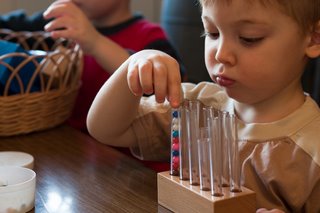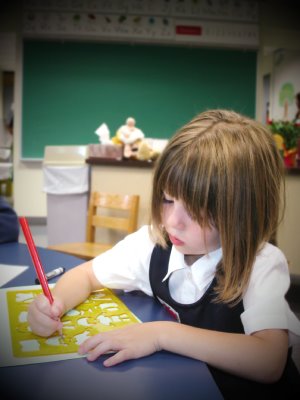I’ve been in Montessori (as a teacher, parent, or both) for over ten years. It’s become so much a part of my DNA that I automatically approach almost every situation – educational or not – from a Montessori perspective. When I think, “That child is normalized”, or “How can we work towards normalization?”, I don’t really think much about the word ‘normalized’ and how it sounds to other people. But I realize using that term can create confusion.
What Does ‘Normalized’ Mean in Montessori?
The dictionary defines ‘normalized’ this way: To make normal, especially to cause to conform to a standard or norm. None of the references I consulted defined it the way Montessori does, probably because Dr. Montessori borrowed the term and made it her own. Because there is more than one meaning, someone unfamiliar with Montessori might assume that we are attempting to make all Montessori children fit into a narrow box where everyone is perfect and perfectly behaved. This is definitely not true.
Rather, the term ‘normalized’ refers to special characteristics that Maria Montessori observed when children were allowed to work freely in a prepared environment. This quote from the North American Montessori Teacher’s Association sums it up nicely:
Dr. Montessori observed that when children are allowed freedom in an environment suited to their needs, they blossom. After a period of intense concentration, and working with materials that fully engage their interest, children appear to be refreshed and contented. Through continued concentrated work of their own choice, children grow in inner discipline and peace. She called this process “normalization” and cited it as “the most important single result of our whole work”.
What are the special attributes that Montessori observed in normalized children? Here they are, as enumerated by E.M. Standing in his book Maria Montessori: Her Life and Work: love of order, love of work, love of silence and working alone, spontaneous concentration, obedience, independence and initiative, spontaneous self-discipline, attachment to reality, and joy.
As you can see, within that list is the freedom for a child to see be him or herself, with all the variances of personalities and abilities that we know exist in the human race. If these traits sounds somewhat familiar, it’s because they’re very similar to the characteristics of an authentic Montessori experience. Let’s take a look at each:
Love of Order
 From infancy onward, Montessori children discover that everything has its place. Our attention to providing a special place for favorite learning materials creates a sense of stability that honors children’s natural love of order.
From infancy onward, Montessori children discover that everything has its place. Our attention to providing a special place for favorite learning materials creates a sense of stability that honors children’s natural love of order.
My children went to a neighborhood Easter-egg-hunt this past Saturday. Basically, a giant field is strewn with small chocolate eggs and all the kids run around seeing how many they can gather. After the hunt was over, the kids ate a few eggs and asked for more. “No,” I said. “We’ll have some more tomorrow.”
“Oh,” said my daughter. “If I can’t eat anymore, I know what I can do with my eggs! I can sort them!” And she sat down and began to sort them according to color. It was lovely to see the characteristic of ‘order’ manifest itself in this way.
A Love of Work, Silence and Working Alone
Most people experience those pleasing times when you become so involved in something that interests you, time slips away unwatched. You don’t want to be interrupted. You’re attending to your mind’s call for a peaceful time of focus; in common psychological vernacular, you’ve entered flow.
Montessori children are provided with interesting work to do, but along with the activity of doing the work, they are partaking of the activity of building-the-self. I cannot overstate the importance of giving the students plenty of time to work uninterrupted. You cannot enter flow when you feel like a bell, timer, or buzzer is going to ring any minute, or that someone else is going to impose a pre-determined ‘schedule’ upon you.
Profound Spontaneous Concentration
Walking through a friend’s beautiful garden, your attention is suddenly caught by a stunning flower. It isn’t enough just to look at it. You must inspect how it grows, touch it with your hands, smell it with your nose. The rest of the pretty garden seems to fade into the background in that spontaneous moment of learning about the wonder of that blossom.
 This is the experience Montessori instructors attempt to promote in students by engaging their focus on important, absorbing learning materials. If the materials have been skillfully presented, they will be worthy of the child’s concentration and rapt fascination will happen naturally.
This is the experience Montessori instructors attempt to promote in students by engaging their focus on important, absorbing learning materials. If the materials have been skillfully presented, they will be worthy of the child’s concentration and rapt fascination will happen naturally.
Obedience
In the Montessori classroom, obedience is never blind or abusive. Traditional education focuses on the principle of children being unquestioningly obedient to a teacher with punishments employed to persuade children away from ‘doing things their own way.’
Instead, Montessori children are encouraged to be obedient to the internal voice that indicates to them what they need to learn next, and when they need to learn it. Additionally, Montessori children come to respect their fellow students, their teacher and their classroom so that they are obedient to the goal of promoting a peaceful place to live and learn.
Independence and Initiative
Happiness for the child is the golden objective of every Montessori instructor and parent. In order to be happy, children need to learn how to work independently, discovering and caring for their own needs to grow emotionally, spiritually and academically.
Pop-psychologists agree that depending on others for happiness is a dangerous modus operandi, and the independent work that goes on in the Montessori classroom gives children the confident skills required to undertake proper tasks at a self-determined time and engage in these tasks with a sense of being able.
Spontaneous Self-discipline
The great genius in Montessori learning materials is that they contain built-in controls that tell students when they have mastered a skill, or when more learning is required. This removes the need for an outside person telling students they’ve ‘failed’. In a system where shaming rebukes are used to correct children in public, the fear of humiliation takes center stage, rather than the desire for skill mastery.
Think about it. When you work a crossword puzzle on a Sunday afternoon, it’s a private engagement for your own satisfaction. If you get a word wrong, the puzzle tells you so because other words begin not to match up – it has a built-in control of error! You go back and correct the initial error to make the puzzle work. All of this goes on inside your own head, and you enjoy the pursuit. It would be a lot different if every time you hit on a wrong word, all of your neighbors announced it, some of them snickered and you got a community reputation of being a real dunce. The zest would certainly be gone from the activity!
Because Montessori children learn to self-correct much of their own work, the discipline of getting things right for one’s own satisfaction is developed. This leads to solving moral dilemmas in future life with the thought that one should act for good, not because one fears discovery of wrong-doing, but because one is eager to do one’s level best.
Attachment to Reality
The Montessori method strives to steer children away from the fantastical so that they develop real skills and habits for living in a real world. Dr. Montessori would not have been a fan of a fairytale which teaches children that if your foot fits in the correct shoe, you’ll be lifted out of poverty, marry the handsome prince and live in a castle for the rest of your life.
She would have been better pleased by a story about a boy reading learning to read by firelight in a log cabin, dedicating himself to a life of public service and eventually, by dint of his energetic efforts, becoming President of the United States and putting an end to slavery. Fantasy teaches children that actions have unreal consequences and Maria Montessori felt it was vital for children to understand the truth of cause and effect in life.
Joy
This is the best of all gifts the Montessori students discover because they are made free to do so by the effort of the adults who care for them. The world’s greatest art, greatest music, literature, scientific achievements, humanitarian triumphs are works of hope and joy. We live on a stunning planet, from the treasures of the rain forest to the mysteries of the deeps. A person can live for a century and only see a small percentage of all of the wonders our world holds for the seeker of joy.
What Does It All Mean?
As they grow, Montessori children, given a free and beneficial environment, learn to approach challenges with gusto and find true joy in acquiring knowledge. A spirit of vivacious activity pervades the Montessori classroom as the students undertake the ongoing work of self-revelation. In addition to this being a wonderful planet, it can be a tough place to live, but ‘normalized’ Montessori traits cultivated early in life will carry a child far in the future.

